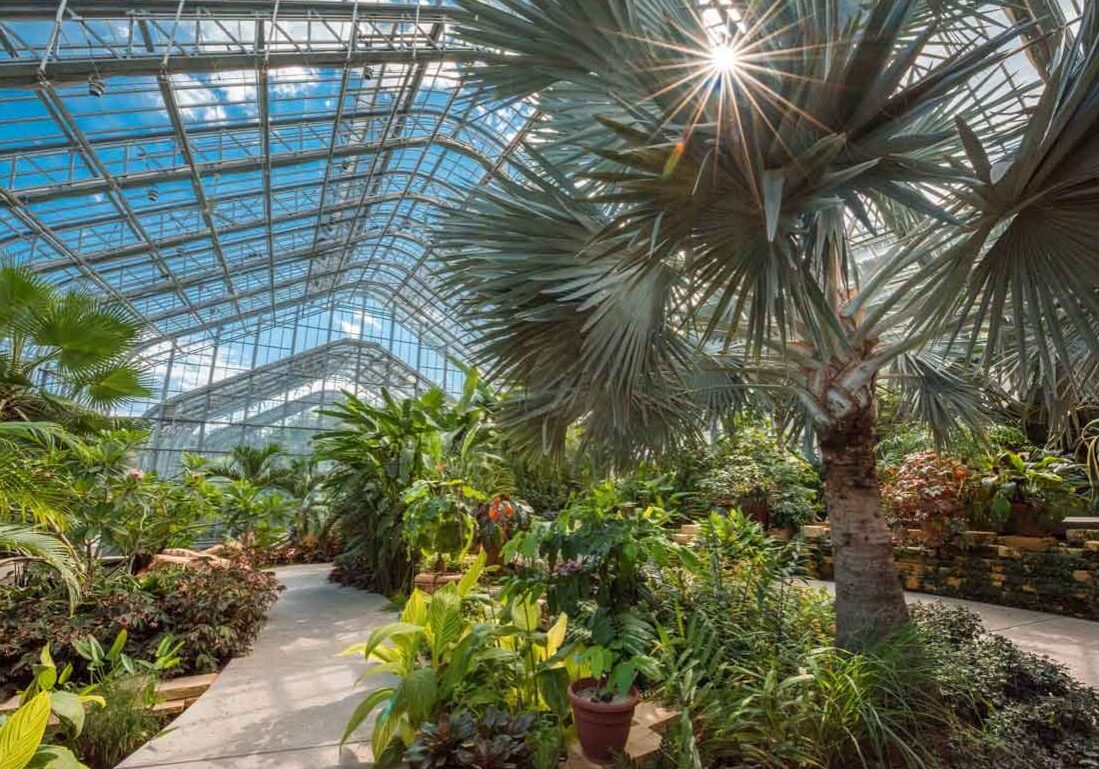
TROPICAL GARDEN
Conservatory (greenhouse)
A conservatory is a building or room having glass or other transparent roofing and walls, used as a greenhouse or a sunroom. Usually it refers to a space attached to a conventional building such as a house, especially in the United Kingdom. Elsewhere, especially in America, it can often refer to a large freestanding glass-walled building in a botanic garden or park, sometimes also called a palm house if tall enough for trees. Municipal conservatories became popular in the early 19th century.
Many cities, especially those in cold climates and with large European populations, have built municipal conservatories to display tropical plants and hold flower displays. This type of conservatory was popular in the early nineteenth century, and by the end of the century people were also giving them a social use (e.g., tea parties). Conservatory architecture varies from typical Victorian glasshouses to modern styles, such as geodesic domes. Many were large and impressive structures and are included in the list below.

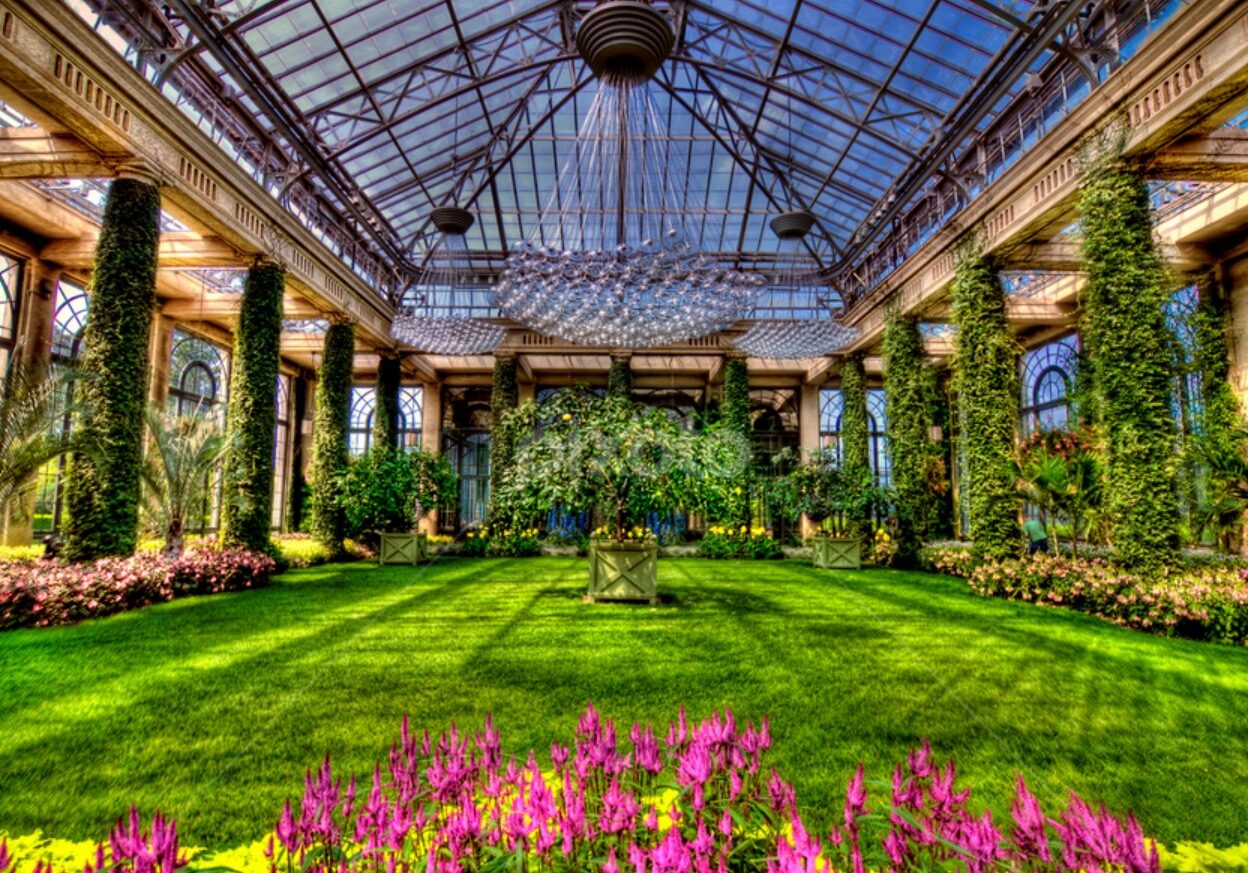
In the UK, the legal definition of a conservatory is a building that has at least 50% of its side wall area glazed and at least 75% of its roof glazed with translucent materials, either polycarbonate sheeting or glass. Today, the terms sunroom, solarium and conservatory are used interchangeably by the public, but in general, the term conservatory and particularly English conservatory evoke the image of an ornate structure, echoing the traditions of that Victorian era of conservatory building. Modern conservatories tend also to be graced with a traditional cresting and finial, along with single, double patio or even bi-folding doors.
These structures have been designed and built around the world, in private gardens, parks, and botanical institutions. Smaller garden conservatories have become popular, which may be dual-function, equally devoted to horticulture and recreation, or favor the latter, as a solarium or sunroom.




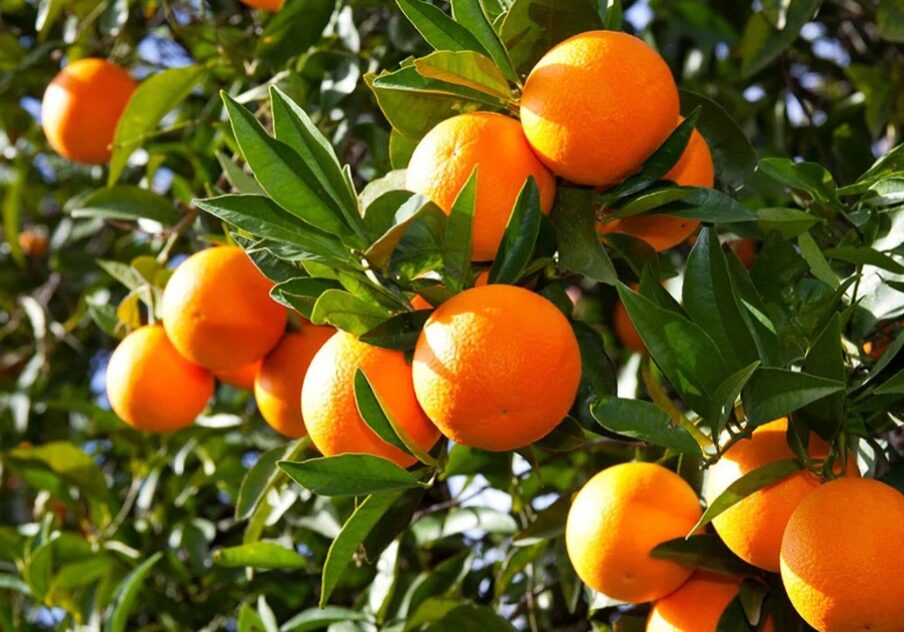
Further north in Europe,
The preservation of orange trees became the trend with special-purpose buildings built to protect the tasty, but delicate fruit. Orangeries, as they came to be called, were typically enclosed structures built with wood, brick or stone with tall vertical windows on the south walls.
The citrus trees were typically in huge pots or tubs, and wheeled outside for the summer months, as at the Gardens of Versailles. Use of these rooms expanded socially and practically, being used to entertain and to host a wider variety of plants.
The word "Greenhouse"
The term greenhouse came to describe the rooms and conservatories for tender plants. In the 18th century, sloped glass began to be used in conservatory design to allow more light into the structure, enhancing conditions for plant growth.
This innovation may have been influenced by the work of Dutch scientist Jan Ingenhousz, who studied the role of light in photosynthesis. However, while his research likely contributed to advancements in horticultural practices, it is not definitively known if he directly influenced the adoption of sloping glass for conservatories



Fruit pLANT & tree pARADISE
Our tropical garden is not only filled with beautiful different species of tropical foliage and flowering plants. But one of our main goals is to have a Fruit tree paradise to share how the common fruits we eat actually grow in nature. You'll get to learn more about the history of where your favorite fruits originate from and how they are grown in nature.

Mandarin Trees
Native to China and Japan, mandarin oranges are semi-tropical trees with thorny branches. The upright trees grow to 20 feet (6 m) or more, so it is difficult or impossible to provide temporary cold protection for them. Young mandarin orange trees need regular pruning to help them grow into a balanced shape.

Papaya Trees
Growing papaya trees is generally done from seed that is extracted from ripe fruit. If you are using fruit from a grocery store, it is most likely going to be a bisexual plant. You should plant several seeds per pot to ensure germination. Under full sunlight, seedlings may emerge in about two weeks. Plants can be set out after they are a foot (0.5 m.) tall and spaced 8 to 10 feet (2.5-3 m.) apart.

Pomelo Trees
Pomelo trees, also known as shaddock trees, are evergreen citrus trees that produce large, sweet fruits. They are native to Southeast Asia and are widely cultivated in tropical and subtropical regions.

Orange Trees
Orange trees are one of the most recognized types of citrus trees featuring full, leafy canopies and fragrant flower displays followed by their famous fruit. A full-size orange tree can grow to 32 feet tall, with dwarf varieties reaching about 12 feet in height.
Orange trees are planted in the ground after the possibility of frost has passed but dwarf trees can be planted any time in containers, which makes them great for indoor gardening, as well. Although the fruit is delicious, the plant itself is known to be toxic to pets

Pineapple Plants
Pineapples are tender herbaceous perennials that can grow 2 to 4 feet tall and have spiky, narrow, long leaves that form a tight rosette, like an agave. The plant prefers 68 to 86 degrees Fahrenheit temperatures for optimum growth.

Lemon Trees
The lemon (Citrus × limon) is a species of small evergreen tree in the Citrus genus of the flowering plant family Rutaceae. The lemon is a hybrid of the citron and the bitter orange. Its origins are uncertain, but some evidence suggests lemons originated during the 1st millennium BC in what is now northeastern India.

Persimmon Trees
It was first cultivated in China more than 2,000 years ago, and introduced to Japan in the 7th century and to Korea in the 14th century. China, Japan and South Korea are also the top producers of persimmon. It is known as shi (柿) in Chinese, kaki (柿) in Japanese and gam (감) in Korean and also known as Korean mango.
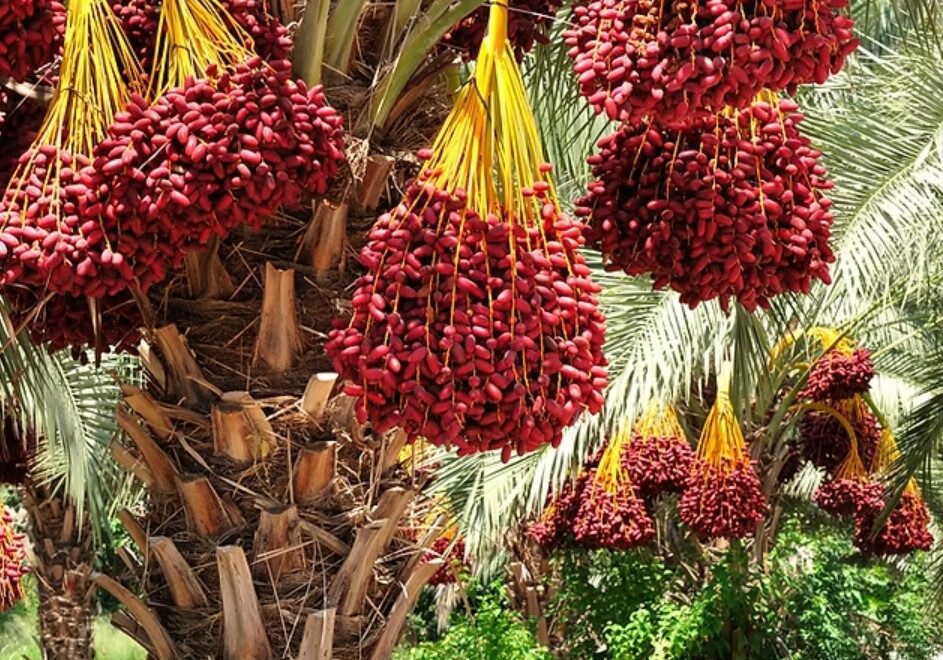
Date Palm Trees
Phoenix dactylifera, commonly known as the date palm, is a flowering-plant species in the palm family Arecaceae, cultivated for its edible sweet fruit called dates. The species is widely cultivated across northern Africa, the Middle East, the Horn of Africa, Australia, South Asia, and California

Kiwi Plants
Kiwi plants can be grown on a vine in both colder and warmer regions. These tasty and nutrient-rich fruits are an excellent choice to grow in your own home.

Lychee Trees
Lychee is a tropical broadleaf evergreen tree native to China, where it grows in a warm, humid climate. Although grown commercially for its fruit (not its flowers), it is often used as a shade or specimen fruit tree in landscapes. The inside flesh of lychee fruit is clear to white with a light, sweet, perfumed flavor, tasting like a watermelon crossed with a pear.
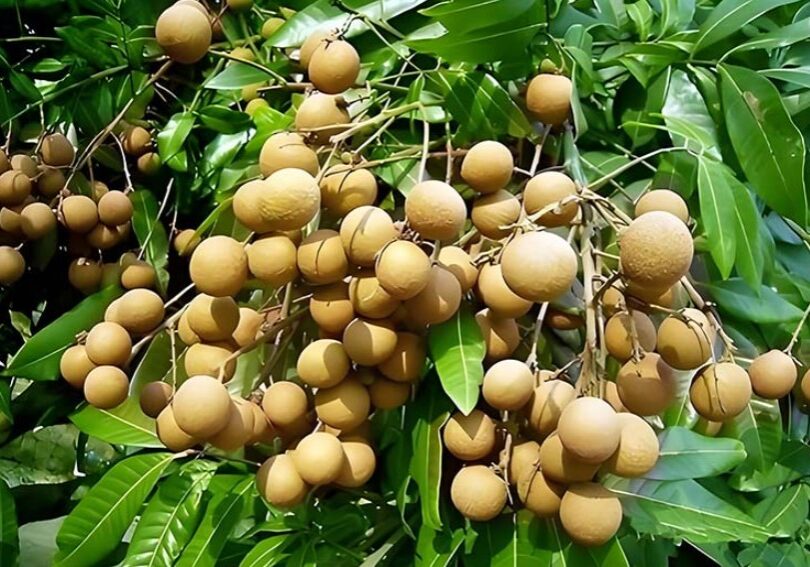
Longan Trees
Dimocarpus longan, commonly known as the longan and dragon's eye, is a tropical tree species that produces edible fruit. It is one of the better-known tropical members of the soapberry family Sapindaceae, to which the lychee and rambutan also belong.

Grape vines
A grape is a fruit, botanically a berry, of the deciduous woody vines of the flowering plant genus Vitis. Grapes are a non-climacteric type of fruit, generally occurring in clusters. The cultivation of grapes began approximately 8,000 years ago, and the fruit has been used as human food throughout its history.
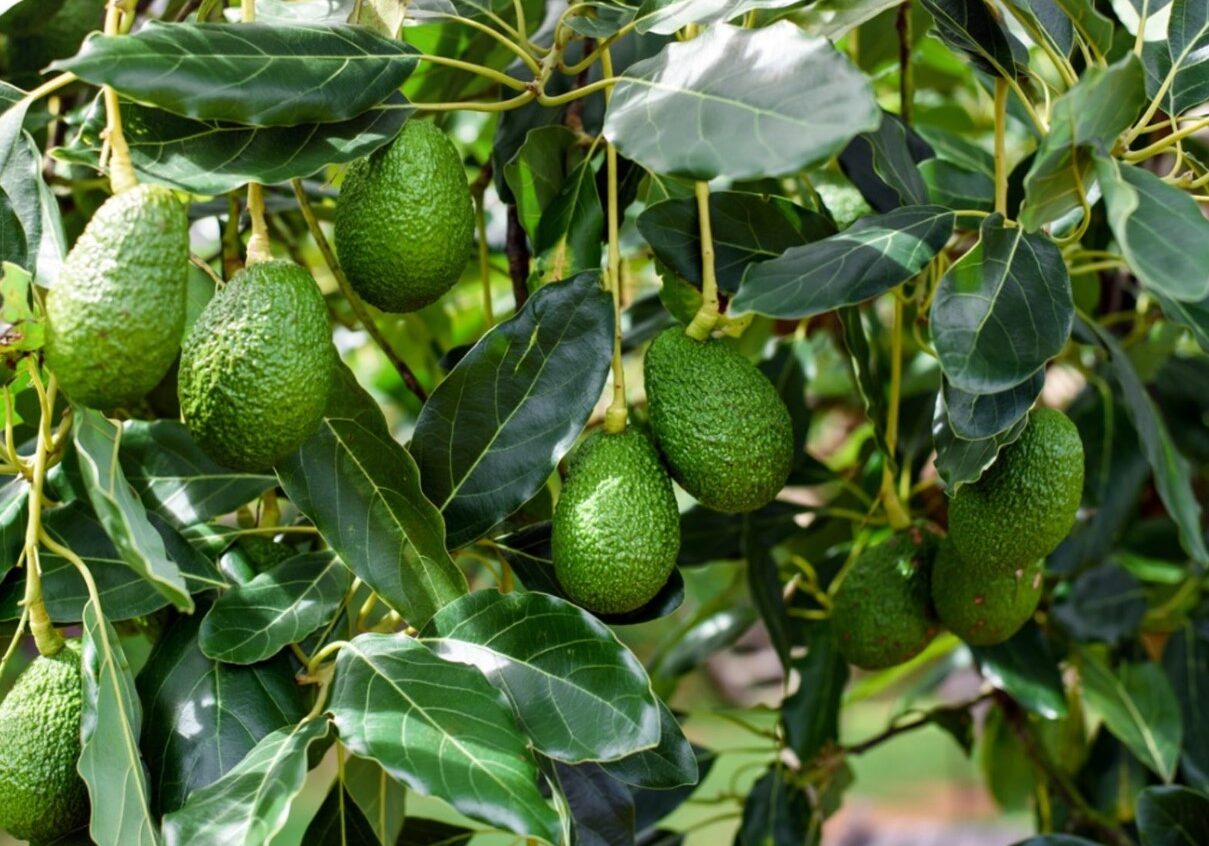
Avocado Trees
The avocado, alligator pear, or avocado pear is an evergreen tree in the laurel family. It is native to the Americas and was first domesticated in Mesoamerica more than 5,000 years ago. It was prized for its large and unusually oily fruit.

Coconut Trees
The coconut tree is a member of the palm tree family and the only living species of the genus Cocos. The term "coconut" can refer to the whole coconut palm, the seed, or the fruit, which botanically is a drupe, not a nut. They are ubiquitous in coastal tropical regions and are a cultural icon of the tropics.

Banana Trees
Bananas are believed to have originated in Southeast Asia up to 10,000 years ago. They were spread by traders and travelers to other regions, and eventually became a staple food in many parts of the world.

Asian Pear Trees
Pyrus pyrifolia is a species of pear tree native to southern China and northern Indochina that has been introduced to Korea, Japan and other parts of the world.
The tree's edible fruit is known by many names, including Asian pear, Persian pear, Japanese pear, Chinese pear, Korean pear, apple pear, zodiac pear, three-halves pear, papple, naspati and sand pear. Traditionally in East Asia the tree's flowers are a popular symbol of early spring, and it is a common sight in gardens and the countryside.

Plum Trees
Plums are likely to have been one of the first fruits domesticated by humans, with origins in East European and Caucasian mountains and China. They were brought to Britain from Asia, and their cultivation has been documented in Andalusia, southern Spain.

Pear Trees
It is thought that pears originated in the Caucasus from where they spread to Europe and Asia and that they were first cultivated more than 4000 years ago. Both the Ancient Greeks and Romans valued the fruit for its flavour and medicinal properties.
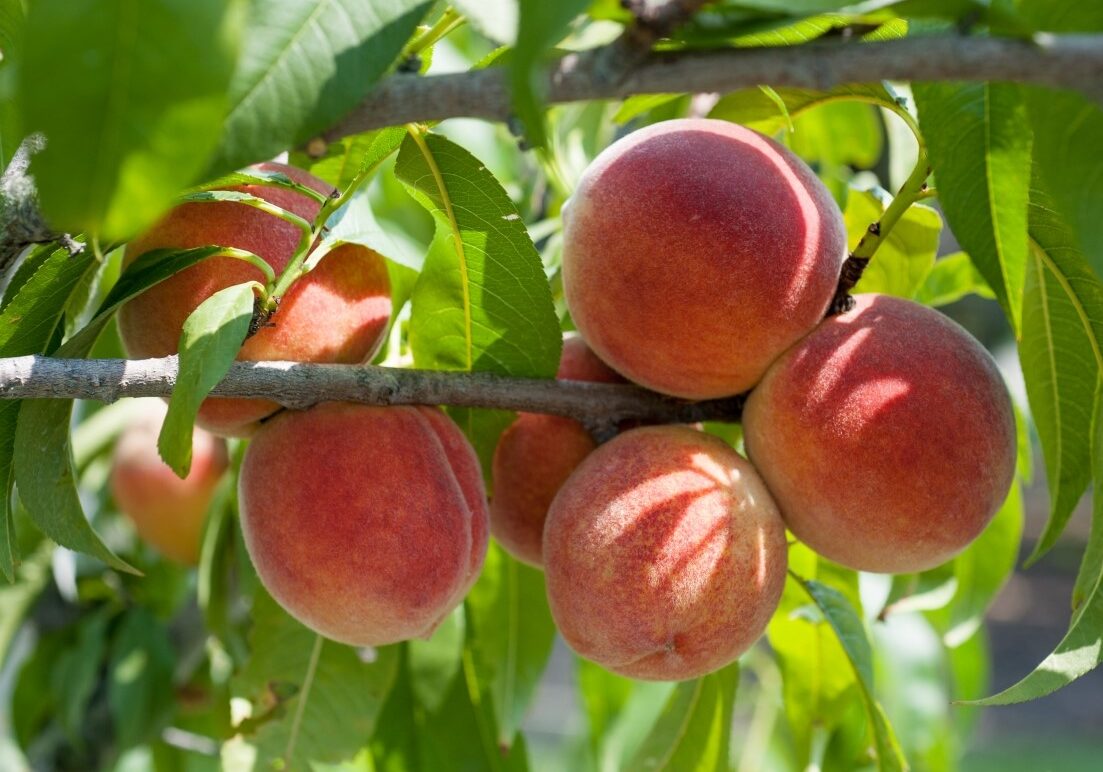
Peach Trees
Peaches originated in China, where they are native to northwest China. Archaeologists believe that peaches in China were first domesticated along the Yangzi River, where they have found fossilized peach stones believed to be from 6000 BC. Historians have found peaches discussed in Chinese writings from the 10th century.
Of specific importance to Chinese culture was the peach blossom, thought to fend off evil spirits and provide vitality. When traveling between towns, Emperors were preceded by soldiers carrying peach blossoms, and each New Year began with peach blossoms hung on front doors all over the county.
To this day, China is the world's leading peach producer. China produces half of the world's peaches - 11 million tons of peaches per year, followed by Italy producing 1.5 tons, and then the USA at 1 ton.

Dracenas
The Dracaena tree, also known as the dragon tree, has a long history of use and cultural significance. The name comes from the Greek word for "female dragon".
The red gum-like resin in the stems of Dracaena was used centuries ago for things like toothpaste, dye, and cures for rheumatism, and dysentery and as a general cure-all for certain tribes. Today, it is more commonly used for varnish (such as for the wood on a violin) and photoengraving.

Peace Lily (Spathiphyllum)
The Peace Lily originates from the tropical rainforests of Colombia and Venezuela, a real shadow plant which loves a warm, humid environment. In 1870 the plant was introduced into Europe and has experienced a huge amount of development since then.

Alocasia Plants
The plant has been cultivated around the Equator as a foodstuff for 28,000 years. Decorative plants have been bred from the original versions. These aren't edible, but they are very beautiful. Alocasia conquered living rooms in the 1950s, and has a great vintage vibe.

Satin or Silver Pothos (Scindapsus Pictus)
Scindapsus pictus—commonly called satin pothos, silver pothos, or silver vine—is a species of flowering plant in the aroid or arum family, Araceae, native to Bangladesh, Borneo, India, Java, Peninsular Malaysia, the Philippines, Sulawesi, Sumatra, Taiwan and Thailand.[2] The Latin specific epithet pictus means "painted", referring to the variegation on the leaves.

Bamboos
Bamboo has a rich history and has been used for various purposes for thousands of years. The earliest evidence of bamboo usage dates back to ancient China, where it was used to make arrows, musical instruments, and writing materials. Bamboo was also used for medicinal purposes in traditional Chinese medicine.

Baobab Trees
The baobab is a prehistoric species which predates both mankind and the splitting of the continents over 200 million years ago. Native to the African savannah where the climate is extremely dry and arid, it is a symbol of life and positivity in a landscape where little else can thrive.

Bromeliads
Bromeliads are a group of tropical flowering plants that originated in the Guiana Shield about 70–100 million years ago. They are thought to have evolved from C3 terrestrial plants growing in moist, infertile areas.

Orchid
The history of orchids intertwines with human civilization, beginning around 4,000 years ago in China and Japan, where these botanical wonders were initially employed for medicinal purposes. Orchids found their place as remedies for various ailments, from coughs and fevers to wounds and infections.
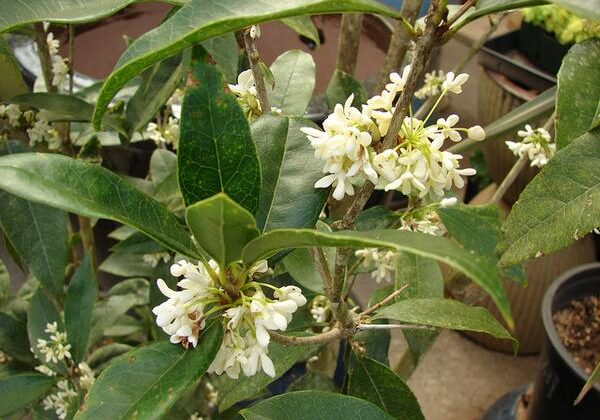
Tea Olive (Osmanthus Gragrans)
Osmanthus fragrans, also known as sweet osmanthus or tea olive, has a long history in China and Japan. It is native to China, Japan, and Southeast Asia. This plant has small but extremely fragrant flowers that appear in the early spring and again in the fall. The genus name comes from the Greek words for fragrant (osme) and flower (anthos). The species epithet means “fragrant.” It was introduced to Europe in the 19th century.

Anthuriums
Anthurium, also called flamingo flowers, are known for their unique, bright red, green, and white colors. The genus Anthurium is a genus of about 1,000 species of flowering plants, the largest genus of the arum family, Araceae. General common names include anthurium, tailflower, flamingo flower, pigtail plant, and laceleaf. Native to Central America, northern South America, and the Caribbean. They can easily be grown outdoors in tropical climates.

Jasmine Trees
The History of the Jasmine Flower. Jasmine is thought to have originated in ancient Persia (modern-day Iran). It was found in Egypt as early as 1000 BCE, spreading from there through nearby countries. In Ancient Egypt, jasmine flowers were added to luxurious hot baths.
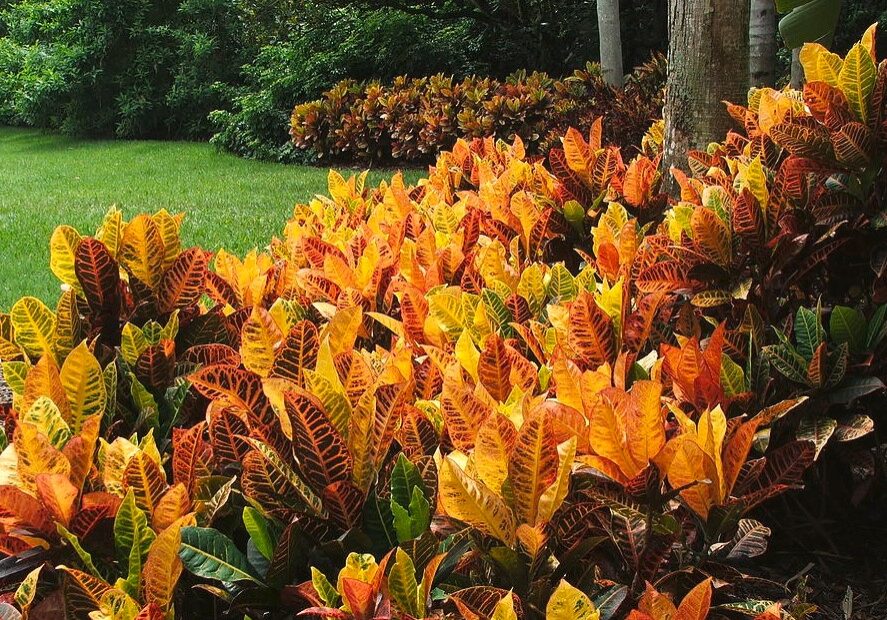
Croton (Codiaeumvariegatum)
The history of the croton plant (Codiaeumvariegatum) is closely tied to the cultures and ecosystems of Southeast Asia and the Pacific Islands. Indigenous people used crotons for centuries in traditional medicine, herbal remedies, and to create dyes.
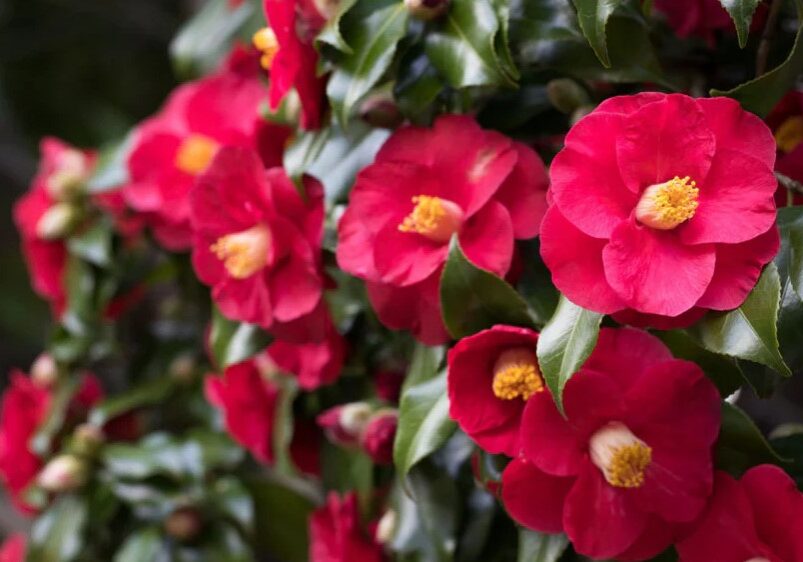
Camellia Japonica
Camellia japonica is a long-lived, slow-growing shrub with beautiful flowers in the winter and spring. Despite its common name, it is native to China, not Japan. The cultivation of Camellia japonica also started in China. Its widespread cultivation can be traced back to the Song Dynasty when 15 varieties of Camellia japonica were recorded in literature. It was later introduced to Japan.

Pachira Aquatica
The history of Pachira aquatica, also known as the money tree, is rooted in its origins in Central and South America. The plant's name and symbolism are based on a story about a poor man who found the plant and made money from selling its seeds.

Ficus Elastica
Originally found in the rainforests of Southeast Asia, Ficus elastica was heavily sought after in the 19th century for its latex sap, which was used to make natural rubber
The Rubber Tree produces a milky-white latex sap once it reaches the age of about 6 years old. This latex has been used worldwide in the past for the manufacture of a wide range of rubber-related products.
